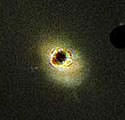
Image credit: Hubble
The Hubble Space Telescope has provided the clearest view of nearby Quasar 3C 273 ever taken in visible light. The image was taken by using the newly installed Advanced Camera for Surveys (ACS), which is able to block the brightest light to show the dimmer parts of the object. Features in the galaxy surrounding the central quasar are clearly visible.
NASA Hubble Space Telescope’s new Advanced Camera for Surveys (ACS) has provided the clearest visible-light view yet of the nearby quasar 3C 273. The ACS’ coronagraph was used to block the light from the brilliant central quasar, revealing that the quasar’s host galaxy is significantly more complex than had been suggested in previous observations. Features in the surrounding galaxy normally drowned out by the quasar’s glow now show up clearly. The ACS reveals a spiral plume wound around the quasar, a red dust lane, and a blue arc and clump in the path of the jet blasted from the quasar. These details had never been seen before. Previously known clumps of hot gas and the inner blue optical jet are now resolved more clearly.
The power of the ACS coronagraph is demonstrated in this picture. The Hubble image on the left, taken with the Wide Field Planetary Camera 2, shows the brilliant quasar but little else. The diffraction spikes demonstrate the quasar is truly a point-source of light (like a star) because the black hole’s “central engine” is so compact. Once the blinding “headlight beam” of the quasar is blocked by the ACS (right), the host galaxy pops into view. Note that the ACS’ occulting “finger” and other coronagraphic spot are seen in black near the top of the ACS High Resolution Channel image.
Quasars (also known as QSOs ? short for quasi-stellar objects) were discovered in the early 1960s, but at least two decades passed before astronomers had observational evidence that they reside in galaxies. They now are commonly accepted to be supermassive black holes accreting infalling gas and dust. Using the ACS, astronomers want to learn what activities in a quasar’s host galaxy feed the black hole, allowing it to “turn on” as a quasar.
Original Source: Hubble News Release
